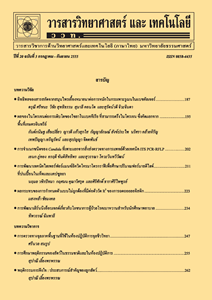การออกแบบหัวเผาเพื่อการปรับปรุงการเผาไหม้สำหรับเผาเตาเซรามิก
Main Article Content
Abstract
Burner is one of the important apparatus that can affect the combustion efficiency in the furnace, especially ceramic industry. This research investigated the improvement of the combustion efficiency in furnace by the modification of dispersion characteristics, number and size of nozzles for fuel and air injection. This study tested three different burners which are B1, B2 and BN types. The experiment was done in the 1 m3 of simulated furnace with natural gas and fuel to air mole ratio of 1 : 10. The flue gas analysis and efficiency were reported. Results showed that a measurement of excess air obtained from burner BN gave the minimum value of 8.5 compared to 12 % excess air for B1 and B2 burners. From the combustion efficiency analysis, burner BN found to be the highest combustion efficiency of 85 % while B1 and B2 burners showed the efficiency of 74 and 73 %, respectively. Therefore, it can be concluded that characteristics of burner influence on the combustion efficiency.
Article Details
References
[2] The Institute of Industrial Energy, 2015, Energy Conservation in Industrial Furnace, Center for Conservation Guidelines in the Industry, Bangkok, 68 p. (in Thai)
[3] Samerjai, S., Improve Furnace for the Reduce Ceramic Industry Energy, Available Source: http://thewindustry.com, February 26 2014. (in Thai)
[4] Saowara, A. and Somkiat, T., 2012, An assessment of energy consumption for high-efficiency burners in shuttle kiln for ceramic industry in Thailand, pp. 1019-1021, Industrial Engineering Network Conference, Silpakorn University, Nakhon Pathom. (in Thai)
[5] Kronenburg, A., 2007, Spray combustion, A fresh perspective, pp. 20-25, Proceedings of the Australian Combustion Symposium, The University of Sydney, Sydney.
[6] Starling, K.E., Ding, E.R., Harwell, J.H. and Mallinson, R.G., 1995, Method for improving natural gas energy density at ambient temperature, Energy Fuels 9: 1062-1065.
[7] Bibrzycki, J., Poinsot, T., Zajdel, A., 2010, Investigation of lamina flame speed of CH4/N2/O2 and CH4/CO2/O2 mixtures using reduced chemical kinetic mechanisms, Arch. Combust. 30: 287-296.

